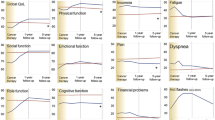Abstract
Goals of work
To determine which individual or groups of “upper-body” daily tasks are considered most burdensome to women following breast cancer treatment, and to assess whether certain patient or treatment characteristics influence task burden.
Patients and methods
A convenience sample of breast cancer survivors ( n =619) completed a self-administered questionnaire regarding 48 daily tasks requiring upper-body function. Women were asked to rate how frequent and physically demanding each task was using a five-point Likert scale, and the product of task frequency and physical demand determined overall task burden. Tasks were ranked to identify the most burdensome individual tasks, while a factor analysis was performed to define independent constructs (groupings) among the tasks. Multiple linear regression models were fitted to consider the independent influences on task groups of various participant characteristics.
Main results
Factor analysis identified seven distinct task groups and the individual tasks considered most burdensome fell in five of these groups, specifically whole body, flexibility, carrying/upper-body strength, hand and weighted flexion tasks. Having lymphoedema or poor fitness was associated with upper-body disability involving all seven task groups, whereas other patient and treatment characteristics were related only to certain types of activities.
Conclusions
Breast cancer survivors report difficulty with a range of upper-body tasks, particularly if they also have lymphoedema or poor fitness. Using all or some of the tasks within the reported constructs in a questionnaire format, or the functional requirements of the most burdensome tasks to develop more objective and quantitative measures, would provide a solid base for the measurement of upper-body function in women with breast cancer.

Similar content being viewed by others

References
Collins L, Nash R, Round T, Newman B (2004) Perceptions of upper-body problems during recovery from breast cancer treatment. Support Care Cancer 12:106–113
Hassey Dow K, Hansen Kalinowski B (2000) Issues in breast cancer survivorship. In: Harris J, Lippman M, Morrow M, Osborne C (eds) Diseases of the breast. Lippincott Williams & Wilkins, Philadelphia, pp 985–1000
Hladiuk M, Huchcroft S, Temple W, Schnurr B (1992) Arm function after axillary dissection for breast cancer: a pilot study to provide parameter estimates. J Surg Oncol 50:47
Jemal A, Thomas A, Murray T, Thun M (2002) Cancer statistics, 2002. CA A Cancer J Clin 52:23–45
Keramopoulos A, Tsionou C, Minaretzia D, Michalas S (1993) Arm morbidity following treatment of breast cancer with total axillary dissection: a multivariated approach. Oncology 50:445–449
Lash T, Silliman R (2000) Patient characteristics and treatment associated with a decline in upper-body function following breast cancer therapy. J Clin Epidemiol 53:615–622
Lash T, Silliman R (2002) Long-term follow-up of upper-body function among breast cancer survivors. Breast J 8:28–33
Petrek J, Lerner R (2000) Lymphedema. In: Harris J, Lippman M, Morrow M, Osborne C (eds) Diseases of the breast. Lippincott Williams & Wilkins, Philadelphia, pp 1033–1040
Pinto B, Trunzo J, Reiss P, Shiu S (2002) Exercise participation after diagnosis of breast cancer: trends and effects on mood and quality of life. Psychooncology 11:389–400
Pinto B, Clark M, Maruyama N, Feder S (2003) Psychological and fitness changes associated with exercise participation among women with breast cancer. Psychooncology 12:118–126
Polit D, Hungler B (1999) Nursing research principals and methods. Lippincott Williams & Wilkins, Philadelphia
Satariano W, Ragheb N, Branch L, Swanson G (1990) Difficulties in physical functioning reported by middle-aged and elderly women with breast cancer: a case-control comparison. J Gerontol 45:M3–11
Satariano W, Ragland D, De Lorenze G (1996) Limitation in upper-body strength associated with breast cancer: a comparison of black and white women. J Clin Epidemiol 49:535–544
Silliman R, Lash T (1999) Comparison of interview-based and medical-record based indices of comorbidity among breast cancer patients. Med Care 37:339–349
Silliman R, Prout M, Field T, Kalish S, Colton T (1999) Risk factors for a decline in upper body function following treatment for early stage breast cancer. Breast Cancer Res 54:25–30
Ververs J, Roumen R, Vingerhoets A, Vreugdenhil G, Coebergh J, Crommelin M, Luiten E, Repelaer van Driel O, Schijven M, Wissing J, Voogd A (2001) Risk, severity and predictors of physical and psychological morbidity after axillary lymph node dissection for breast cancer. Eur J Cancer 37:991–999
Vinokur A, Threatt B, Caplan R, Zimmerman B (1989) Physical and Psychosocial functioning and adjustment to breast cancer. Cancer 63:394–405
Wingate L (1985) Efficacy of physical therapy for patients who have undergone mastectomies. Phys Ther 65:896–900
Acknowledgements
This work was funded in part by a research grant from the National Breast Cancer Foundation.
Author information
Authors and Affiliations
Corresponding author
Rights and permissions
About this article
Cite this article
Hayes, S.C., Battistutta, D., Parker, A.W. et al. Assessing task “burden” of daily activities requiring upper body function among women following breast cancer treatment. Support Care Cancer 13, 255–265 (2005). https://doi.org/10.1007/s00520-004-0729-8
Received:
Accepted:
Published:
Issue Date:
DOI: https://doi.org/10.1007/s00520-004-0729-8



